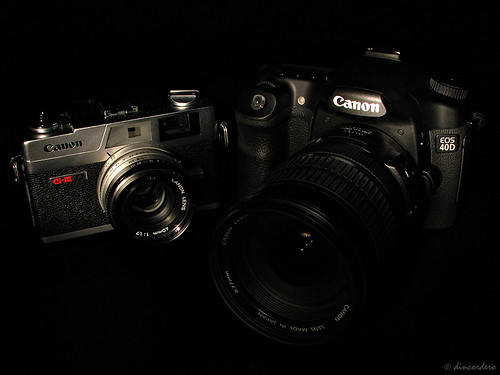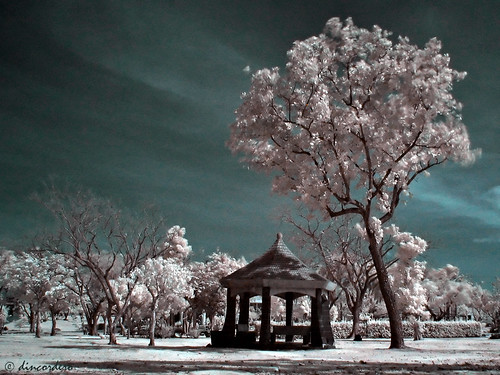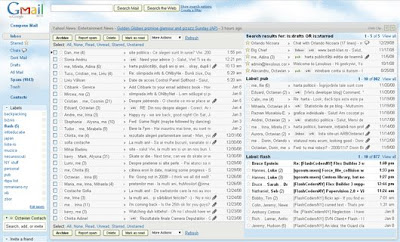Feb 27, 2009
The World Inside a Coca-Cola Vending Machine
How I wish that the new Coke ads are as beautiful and creative as this one.
Labels:
advertisement,
maven
First Time. First Love.
Do you remember this ad? Do you remember the song?
This Coke Ad first came out in 1987. Wow! This really brought back good ol' memories. It perfectly captured the fire and intensity of youth. Thanks to one of my team members who found it.
Labels:
advertisement,
maven
Feb 26, 2009
Stand up. Finish Strong!
When I saw this video about Nick Vujicic, I remembered the old adage, "I was complaining that I had no shoes until I met a man who had no feet."
On the other hand, even if Nick is without limbs, he has been a constant source of inspiration and strength to those who are facing challenges and obstacles in their lives. He indeed stood up and finished strong!
Labels:
inspiration,
psychology
Feb 25, 2009
Psychological Effects of Social Networking Sites
I think we need more researches in this field especially now that social media is already ubiquitous in our lives. I think we need to learn what are the potential biological and psychological side-effects of the social media.
Here's the latest research that I was able to find. Baroness Greenfield, director of the Royal Institution, warned that social networking sites such as Facebook and Twitter are "changing children's brains" making them more self-centred and reducing their attention spans. According to her, these sites pose the risk of "infatilising" the minds of the children since they are replacing face-to-face interactions which are key to the development of a child's sociability.
To get more details about this research, click here.
Labels:
psychology
Feb 24, 2009
Ben Stiller's Top Performance in the Awards Night
Ben Stiller parodied Joaquin Phoenix when presenting the Cinematography nominees. All hail to Ben, the "serious" comedian!
If you are wondering what is the context of this parody. Take a look at this.
Feb 21, 2009
How Hollywood (Still) Misuses Technology

Image screencaptured from NetworkWorld
The Oscars for this year is already knocking at the door (airing this Sunday, February 22 to be exact) but the folks at NetworkWorld, "in honor" of the Academy Awards, compiled the top movies for what they call the 404 Awards. This recognizes how Hollywood movies still applies technology wrongly. Sit back and enjoy the slideshow.
Feb 19, 2009
Flickr Explore and FlickrLeech

FlickLeech Adobe Air application
Whenever I feel I am in a photographic rut, I always visit Flickr's Explore Page (or commonly known as Interestingness) to be inspired and bathe in the creative juices of fellow photographers worldwide. Unfortunately though, it was quite a chore to scroll through 50 pages of the day's top 500 images. What more if you plan to go through several days or even months worth of top images.
This is where FlickrLeech, created and maintained by Andrew Houser, is heaven sent. What it does is show in one page all of the top 500 images of the day. It was previously a web site but due to the strain brought about by loading 500 images (even if these were just small preview images), the server hosting the site brought it down.
As a result, Andrew converted FlickrLeech into a desktop application utilizing Adobe Air. You can download the program here or just visit FlickrLeech's site and get more information as well. Be aware though that the program is still in Alpha stage meaning you can encounter some errors while using it. In case you encounter one, you can send your feedback to Andrew's email address.
Labels:
Flickr,
photography
Feb 18, 2009
Macrophotography: Extension Tubes

Image from Kenko
Using extension tubes is one of the cheaper alternatives in doing macrophotography. These tubes are exactly just that, tubes that extend or move the lens away from the camera film or digital sensor. As a result, the lens can focus closer, magnifying the subject in the process. The longer the extension, the greater the magnification.
You will be encountering 3 limitations though. First, extension tubes cause light loss. The farther the lens from the camera film or digital sensor is, the greater the light loss. As a result, this will cause a darker viewfinder and longer exposures.
Second, the longer the lens' focal length, the lower will be the magnification. Conversely, the shorter the focal length, the higher the magnification. This can be computed using the formula below
M = Y/X
where:
M = magnification
Y = total length of the extension tubes in mm
B = lens' focal length in mm
As a result, if you have a 50mm lens and the total length of the extension tubes is 68mm, magnification will be 1.36x or 1.36:1. On the other hand, if you have a 100mm lens attached to a 68mm extension tube, the magnification will just be less than life-size or 0.68x to be exact.
Third, the shorter the focal length of the lens, the closer the subject needs to be to the lens to achieve focus. All lenses has a minimum focusing distance. For example, the minimum focusing distance of the Canon 50mm lens is 0.45m or 1.5 ft. Attaching a 68mm extension tube to this lens results to a reduction in the minimum focusing distance to about 4 inches. If you are dealing with a lens whose focal length is shorter than 5omm, there will be a high probability that the minimum focusing distance between the subject and the lens will be very small. This will be quite impractical if your potential subject is an insect.
By the way, you may be wondering what is the process for computing the minimum focusing distance for a lens attached to an extension tube. It is not quite exact, well as per my research, but I found a great forum thread which discussed this topic.
There are many types of extension tubes depending on the manufacturer. One of the most popular, which I currently use, is manufactured by Kenko (see image above). It is composed of 3 tubes with various lengths, 12, 20 and 36mm respectively. You can use the tubes separately or you can combine or stack all three to get the 68mm length.

Images from Amazon
Canon has its own set of extension tubes, albeit more expensive than the Kenko tubes. One is 12mm in length while the other one is 25mm. You can also use these tubes separately or you can combine both to get 37mm.
If you like to experiment or the Do-It-Yourself (DIY) type, you can also make your extension tube. As I mentioned above, the concept behind these tubes is just to move the lens away from the camera film or digital sensor. If this is the case, you can use any material for the tube as long as it is sturdy and you can place the right adapters so that you can attach it to the lens and camera body. I found two DIY extension tube examples from the Net, one made from a PVC pipe and the other one from a Pringles can, both did a great job in getting great macro images.
You may be asking now, what is the difference then between the DIY and the commercial tubes (except of course for the price). Well, from my standpoint, that will just be the presence or the lack thereof of electronic contacts connecting the lens and camera body. The commercial tubes have electronic contacts which allow you to get camera metering and even focusing. For the DIY tubes, these do not have the contacts thus you need to manually set the metering and even the aperture of the lens. I will be discussing how to do this in my next post when I tackle how to use reversed lens where you will encounter the same problem, the lack of electronic contacts between the lens and the camera.
To give you a sample of what you can get using extension tubes, you can find below a slideshow of the images I captured using a Canon 50mm lens and Kenko extension tubes.
Labels:
Canon,
macrophotography,
photography
Feb 17, 2009
Macrophotography: Measuring Magnification
Magnification is the differentiating factor between macrophotography and closeup work. Anything equal to or higher than 1x magnification (or 1:1 which means the image is the same size as the object being photographed), this is considered to be a macro. Anything lower than 1x magnification is considered to be a closeup.
To measure the magnification of your macro gear setup, get a ruler with mm scale. Take a picture of the ruler focusing on the mm scale. Ensure that you will be able to get a measurement of the image's width in mm. Now, get the width size of your digital camera's sensor. For example, for a Canon 40D, it's 22.2mm. A great resource for this information is Digital Photography Review. Now, divide your sensor's width to that of the width in mm from your image.
As an example, based on my test image below, the width's size is approximately 13mm. Using the Canon 40D sensor size, we divide 22.2mm with 13mm.

Click image to enlarge.
22.2/13 = 1.7. As a result, the magnification of this macro gear setup is about 1.7:1 or 1.7x magnification.
Another example based on my test image below, the width's size is approximately 6mm.

Click image to enlarge.
22.2/6 = 3.7. This is equivalent to 3.7:1 or 3.7x magnification. This is already enough to make a tight portrait of an ant or fly.
To measure the magnification of your macro gear setup, get a ruler with mm scale. Take a picture of the ruler focusing on the mm scale. Ensure that you will be able to get a measurement of the image's width in mm. Now, get the width size of your digital camera's sensor. For example, for a Canon 40D, it's 22.2mm. A great resource for this information is Digital Photography Review. Now, divide your sensor's width to that of the width in mm from your image.
As an example, based on my test image below, the width's size is approximately 13mm. Using the Canon 40D sensor size, we divide 22.2mm with 13mm.

Click image to enlarge.
22.2/13 = 1.7. As a result, the magnification of this macro gear setup is about 1.7:1 or 1.7x magnification.
Another example based on my test image below, the width's size is approximately 6mm.

Click image to enlarge.
22.2/6 = 3.7. This is equivalent to 3.7:1 or 3.7x magnification. This is already enough to make a tight portrait of an ant or fly.
Labels:
Canon,
macrophotography,
photography
Feb 16, 2009
Macrophotography: Raynox DCR250
I started with macrophotography when I bought the Raynox DCR250 out of curiosity. This is a closeup filter that you can snap-on to lenses with 52 to 67mm filter sizes. This is how the Raynox looks like attached to my Canon S2 IS via the Canon Conversion Lens Adapter (LAH-DC20).

Click image to enlarge.
This setup is not for the faint of heart though. It looked deceptively simple but when the lens is zoomed to its maximum (equivalent to 432mm), you will get about 2x magnification. At this magnification level, a slight twitch from your subject or a light breeze will look like a storm of movement from the viewfinder. If you do not have a stable support or your blood is laced with caffeine, you will always end up with blurry images.
You can find below a slideshow of the images I captured using the Raynox.
By the way, you may be wondering what is that thing covering the pop-up flash. That is my home-made flash diffuser cut from a small water sprayer. It is a big help in cutting down the harshness of the light from the flash, all the more essential when you are close to your subject.

Click image to enlarge.
This setup is not for the faint of heart though. It looked deceptively simple but when the lens is zoomed to its maximum (equivalent to 432mm), you will get about 2x magnification. At this magnification level, a slight twitch from your subject or a light breeze will look like a storm of movement from the viewfinder. If you do not have a stable support or your blood is laced with caffeine, you will always end up with blurry images.
You can find below a slideshow of the images I captured using the Raynox.
By the way, you may be wondering what is that thing covering the pop-up flash. That is my home-made flash diffuser cut from a small water sprayer. It is a big help in cutting down the harshness of the light from the flash, all the more essential when you are close to your subject.
Labels:
Canon,
macrophotography,
photography
Feb 15, 2009
The Latest: The Beauty and the Beast

These are my current camera gears. One is more than 20 years old while the other one is 3 months old.
I was very lucky when I had the privilege to buy Daniel Go's Canonet G-III QL17. I had been looking for one for quite some time now since I am very interested in trying my hands on film. My heart skipped a beat when I laid my hands on this beauty. The sheer simplicity and quality made me understand why the camera lasted and still operational for all those decades.
I sold my Canon 350D which was my photography companion and provided me with great service for 2 years. I decided to sell it though to utilize the new technologies and features found in the Canon 40D. This new model is a beast in terms of features. What I had a hard time doing in my 350D, I can easily accomplish with the 40D.
Labels:
Canon,
photography
The Beginning: Canon S2 IS

This was the camera that opened my world to the beauty and challenges of photography. It was a Canon S2 IS and even if it was a point and shoot camera, through it, I was able to learn the foundations of photography and got amazing pictures.
The most important accessory I bought for the S2 IS was the Canon Conversion Lens Adapter (LAH-DC20).

Through this adapter, I was able to attach filters in front of the lens. My two most favorite filters were a close-up filter (for macrophotography) and an infrared filter (for infrared photography). You can find below two pictures I took using the S2 IS with these filters.
Macrophotography

Infrared Photography

I would be explaining in details in later posts about the gears and workflow I used to get the two pictures above.
Labels:
Canon,
infrared photography,
macrophotography,
photography
Feb 12, 2009
Wunderkinds

Image from Engadget
I read this article from Reuters about 2 weeks ago regarding a 9-year old boy from Singapore who developed an iPhone application which has been downloaded over 4,000 times. Besides this accomplishment, he already knows 6 other programming languages. This reminded me of the 9-year old girl from India who became the youngest Microsoft Certified Professional. She is currently reviewing for the Microsoft Certified Systems Engineer exam.
I was kidding with friends before that if ever I have a child, by the age of 9, he/she already knows how to program in C/C++. It was a tongue-in-cheek statement but because of these news, this is no longer a laughing-stock.
Quite astounding feats for such young children don't you think so! You may be wondering how did they do it? Genes? Environment? Parental support and motivation? Combination of these 3? Common sense will dictate that these 3 factors are indeed critical but I'll provide another perspective in providing an explanation.
This will be in the realm of psycholinguistics, which is defined in Wikipedia as, "the study of the psychological and neurobiological factors that enable humans to acquire, use, and understand language." To summarize the language development process, children roughly go through these 4 stages.
| Stage 1 | Babbling stage | 4 months old |
| Stage 2 | One-word stage | 1 year old |
| Stage 3 | Two-words stage | 2 years old |
| Stage 4 | Complex-sentences stage | 2 years old and onwards |
According to studies, a three-word stage seemed to be non-existent. Once a child move pass the two-word stage, they will start speaking longer, more complex phrases and eventually sentences.
Now, let us go to programming languages. Behind the seeming complexity and otherworldliness, they are just that, another language with its own set of grammar, semantics and syntax. If a child is exposed to these components of programming languages, he/she can easily pick up and learn the new "language."
In fact, based on various researches, the younger a child learns a second, or third or more languages, the better. The ballpark age will be on or before 7 years old. As Lewin Thomas, the author of the Fragile Species, aptly described, "Childhood is the time for language, no doubt about it. Young children, the younger the better, are good at it; it is child's play. It is a onetime gift to the species."
Labels:
psychology
Feb 10, 2009
Health Energy Potion
I am surprised that it was only recently that somebody thought of creating an energy drink packaged similarly to the health potion used in the extremely popular video game, Diablo. I vividly remember more than 8 years ago, 2 days after Diablo II was officially released, that I bought the game and played for 4 consecutive days hacking my way through demon hordes and eventually defeating an Über-Diablo. I think I nearly busted my mouse and almost got carpal tunnel syndrome. It would have been nice if this health energy potion was already available back then!
The potion is being sold by ManaPotions and comes in 2 versions, the red health potion or the blue mana potion. It is claimed to contain as much "caffeine as 2 cans of red bull." Talk about punch! Click here for a review from the good folks of CrunchGear. Enjoy the funny video as well.
Labels:
maven,
video game
Feb 8, 2009
Street Fighter IV Opening Movie
When I saw this beautifully rendered opening movie of the upcoming Street Fighter IV, I could not help but go back in time more than 10 years ago when I first played Street Fighter II. I was groping my way through back then on how to execute the infamous Hadōken and Shōryūken moves of Ryu and Ken. Actually, both characters before were just mirror images of one another sharing the same moves and even sprites. The only distinguishing factors between the two were the color of their clothes and their heads. This is quite different now where the moves and fighting styles of Ryu and Ken have been made distinct.
I do not know what is in store for the future of the Street Figher franchise. Looking back at its 2 decades of history though and reviewing its latest incarnation, I think the future is bright.
Labels:
maven,
video game
Gmail's Multi-Pane Inbox

This is not my Gmail Inbox. I got the image from Gizmodo.
I have been an avid Gmail user for more than 5 years now. As proof, my current storage is now at 7.3GB. I made Gmail as my default webmail account due to several reasons.
1. It was the first to offer a huge storage space of 2GB. Other accounts before (5 years ago) only offered a puny 100MB.
2. I liked the email thread feature. This helped me easily track the progress of the "email conversation."
3. Innovation. Innovation. Innovation. New features are constantly being introduced by the Gmail Lab folks. Their latest incarnation is the Multi-Pane Inbox, a boon for multitaskers and "attention-deficit" folks like me.
To enable this feature, go to your Gmail settings and click Labs. Look for Multiple Inboxes and enable it. After saving your changes, you will see a new Multiple Inboxes tab in Settings. Here, you will be able to define the position of the new Inbox Panes as well as its contents. If you have previously defined labels, you can use the label name as the content source for the pane following the format is:LabelName or label:LabelName. Pretty nifty isn't it! Click here for more information.
Feb 5, 2009
Tekken 6 Trailer
I used to play Tekken starting with version 2 up to 4 including Tekken Tag. Most often than not I played in arcade shops which included the occassional challenges with other players. Ah, I found this to be the good old days of gaming where challenges were done face-to-face, side-by-side with a crowd of fanboys at the back. Now, most are done virtually, online.
Unfortunately, I stopped playing in the arcades when I tried my hand with Tekken 5. I was beaten miserably, by the game's AI! It was probably because of the new moves that I am no longer familiar with or age catching with me (reflex was no longer as fast as before), or a combination of the two.
Now, I just play its PSP version (Tekken Dark Resurrection), occassionally drop by in arcade shops and watch the latest crop of players trying to outwit each other or look for the latest Tekken videos. Here's the latest one I found, a beautifully rendered trailer for the upcoming Tekken 6 for PS3 and Xbox 360.
Labels:
PSP,
video game
Pepsi Max I'm Good Ad
I was a Coke drinker for almost a decade until I got a chance to taste Pepsi Max. There was no turning back afterwards. I was hooked!
Nothing against Coke but from my biased standpoint, Pepsi Max tastes a lot better, by a mile actually, than Coke Zero or even the Regular Coke. Even Pepsi's advertisements are a lot cooler than Coke's. Just like this one. Enjoy.
Labels:
advertisement,
maven
Feb 4, 2009
Facebook Turning 5

On the eve of its 5th birthday, Facebook released several images showing the evolution of its interface / web design. Click here for more details from TechCrunch.
I have been using Facebook for less than 5 months, yeah I know I started late in riding the bandwagon but right from the start, I am hooked and that is an understatement.
PCWorld also listed 5 reasons why Facebook is loved. I definitely agree with #2 an #5. Facebook has a clean interface and actually from my standpoint, a great case study for usability and information design. Its interface is worlds apart from Friendster's layout which is confusing to say the least. I also agree with the great applications available. I am currently burning the keys with Hatchlings, Bowling Buddies, and Word Challenge.
Labels:
maven
Google Chrome Ad
I liked the concept, the simplicity and the subtle messages the ad conveyed.
Labels:
advertisement,
Google,
maven
Feb 2, 2009
Don't Fight Monday
It's Monday again folks. Here's a recently found video for all of us.
Labels:
psychology,
YouTube
History of the Internet
A great video I found in YouTube about the history of the Internet. What's amazing here is how the information has been designed in order to clearly explain and deliver a technically complex and information-rich story.
Labels:
information architecture,
maven
Feb 1, 2009
YouTube Interactive Game
I digress again from my Loco Roco series but I cannot help but post this creative game (time waster in other words) which according to Gizmodo is the first interactive YouTube game. Finally, a great use for YouTube annotations! Enjoy the game.
[By the way, if you are stuck, just pause it. It is still a video. =p}
[By the way, if you are stuck, just pause it. It is still a video. =p}
Subscribe to:
Posts (Atom)